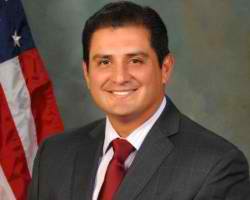The relationship between the United States and Mexico is instrumental in achieving environmental and economic success on both sides of the border. The opportunity to live, work and represent a district which encompasses the busiest border in the nation is a rewarding experience and I am proud of what my efforts have contributed thus far.
To date, we have accomplished the expansion of the San Ysidro Port of Entry and the opening of Cross-Border Xpress, a sky bridge which connects Tijuana’s A.L. Rodríguez International Airport with San Diego. Extraordinary efforts are also being made to complete Otay Mesa East, a toll route which is currently in the design phase. These projects are all pieces of a larger unified system which will create an efficient border. Yet there is more to do.
California ports of entry are a gateway for commerce. However, these ports are extremely congested with wait times up to 3 hours. In the last year alone, vehicle wait times at the San Ysidro Port of Entry increased 71% on weekday travel. A SANDAG study estimates border gridlock costs the U.S. and Mexico $7.2 billion a year.
As your State Senator, it has been one of my top priorities to pass and introduce significant legislative proposals that may help alleviate the congestion at our nation’s busiest border crossing. In 2014, Governor Brown signed a bill which would provide infrastructure improvements along regional and federal trade corridors and ports of entry. However, Governor Brown has yet to release the funding for this effort.
In addition, I introduced a bill in 2015 which would authorize the issuance of the California driver’s licenses and passport in one. The card would contain radio frequency identification (RFID) chips in order to interface with existing technology and expedite border crossings. Unfortunately, Governor Brown vetoed the bill, citing that the existing U.S. Passport card can accomplish the same goal. I, respectfully disagree with the Governor.
According to the State Department, in 2013 approximately 52% of Californians were issued passports. Less than 2% of those applied for a passport card which is outfitted with RFID technology and can be used to cross the border in a faster more efficient way. The notion that applying for a U.S passport card through the federal government solves the problem does not support the staggering low number of people without a card. Bottom line, Governor Brown’s veto eliminates a more convenient and inexpensive option for people to cross the border faster. More importantly, it eliminates the opportunity to stimulate the economy and break a major barrier on the current congestion.
Our port of entry is not only a “long line” as many may see it; it is a monumental opportunity to build on California’s economic prosperity and success. According to the Associated Press in 2014, Governor Brown pledged he would speed up border crossings, “If we can put a man on the moon, we can put a man from Mexico to California in 20 minutes.” I look forward to hearing his plan and seeing what efficient border policies he has in mind to overcome this challenge.
State Sen. Hueso represents the 40th District, which includes Chula Vista and National City.















